Abstract
Several families of putative transposable elements (TrEs) in both solanaceous plants and Caenorhabditis elegans have been identified by screening the DNA data base for inverted repeated domains present in multiple copies in the genome. The elements are localized within intron and flanking regions of many genes. These elements consist of two inverted repeats flanking sequences ranging from 5 bp to > 500 bp. Identification of multiple elements in which sequence conservation includes both the flanking and internal regions implies that these TrEs are capable of duplicative transposition. Two of the elements were identified in promoter regions of the tomato (Lycoperiscon esculentum) polygalacturonase and potato (Solanum tuberosum) Win1 genes. The element in the polygalacturonase promoter spans a known regulatory region. In both cases, ancestral DNA sequences, which represent potential recombination target sequences prior to insertion of the elements, have been cloned from related species. The sequences of the inverted repeated domains in plants and C. elegans show a high degree of phylogenetic conservation. While frequency of the different elements is variable, some are present in very high copy number. A member of a single C. elegans TrE family is observed approximately once every 20 kb in the genome. The abundance of the described TrEs suggests utility in the genomic analysis of these and related organisms.
Full text
PDF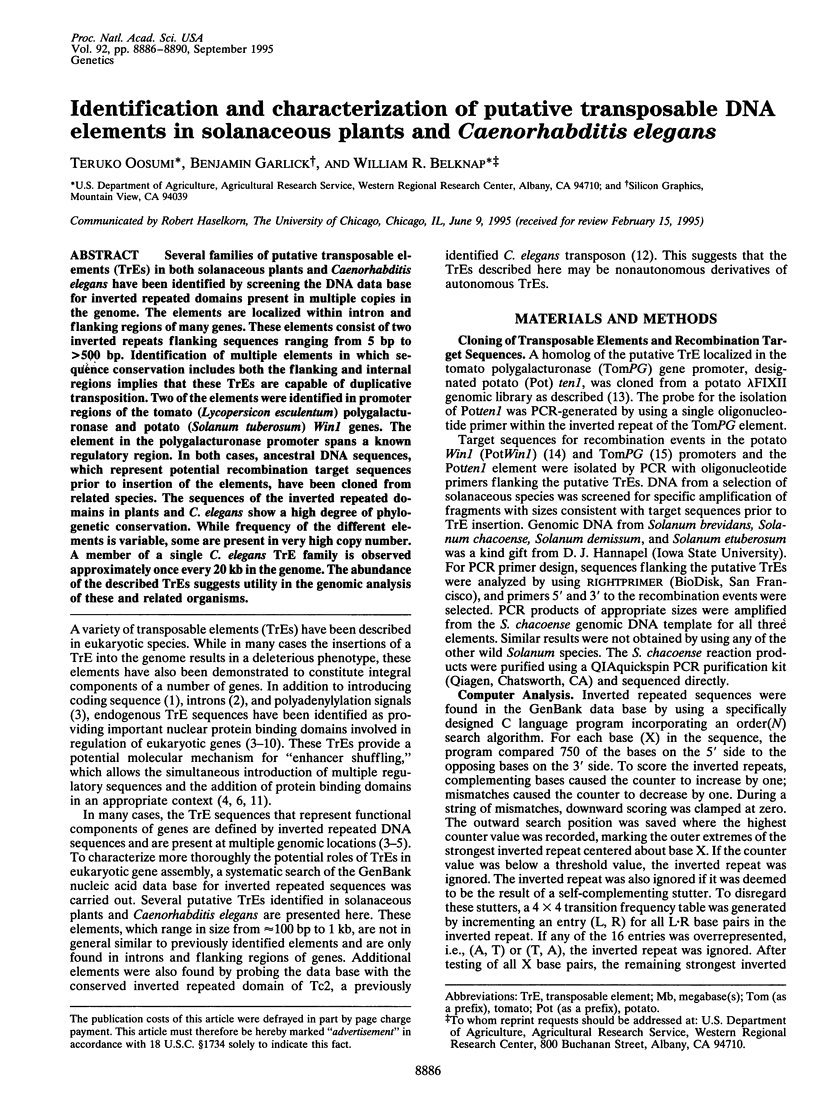
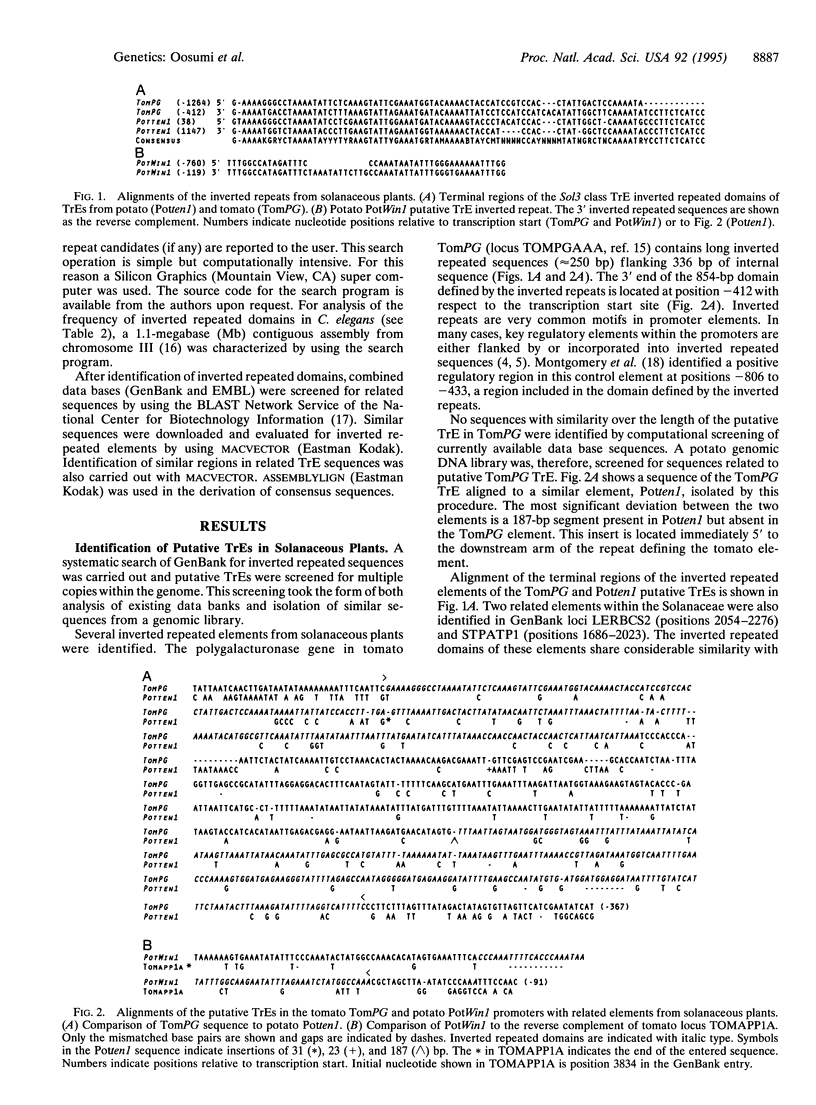
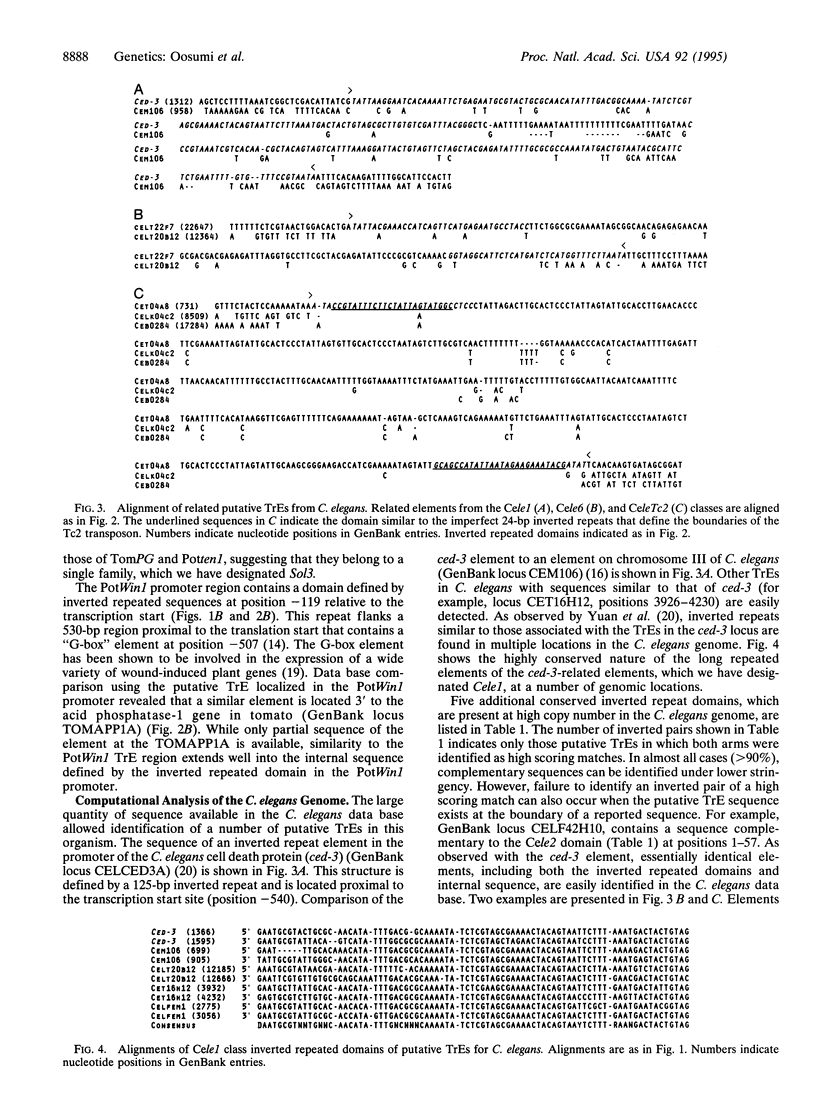
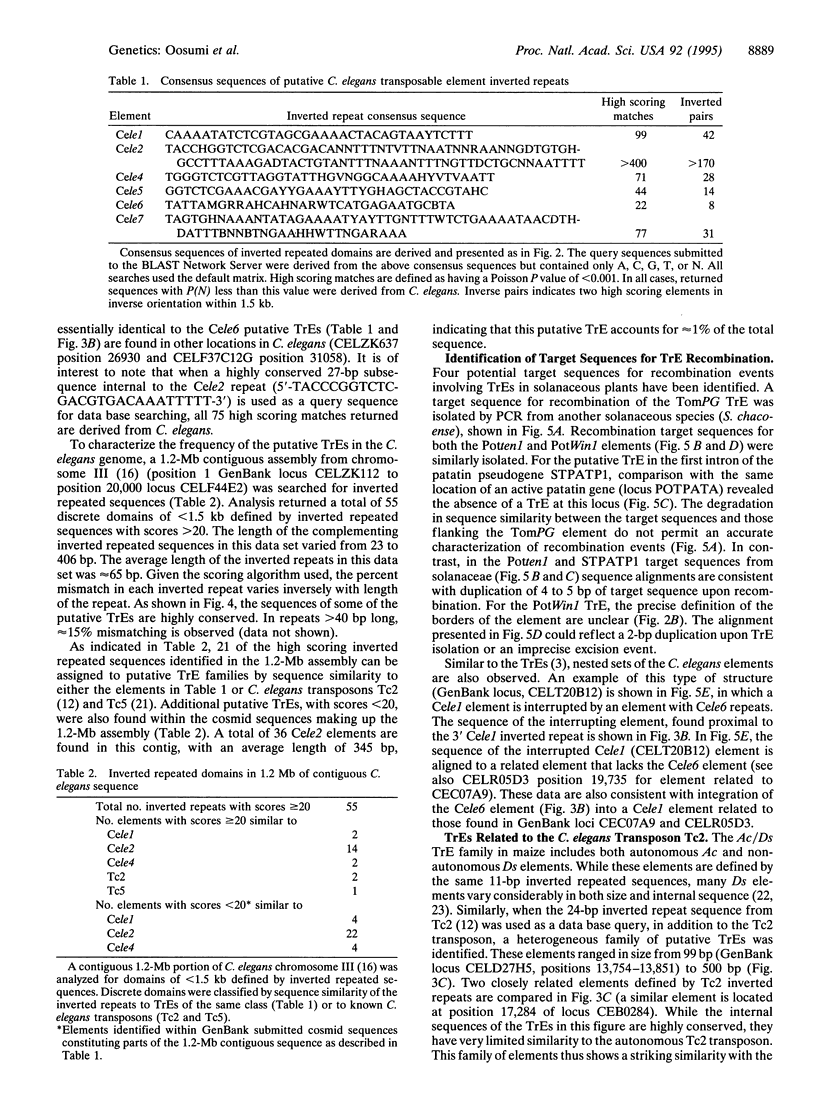
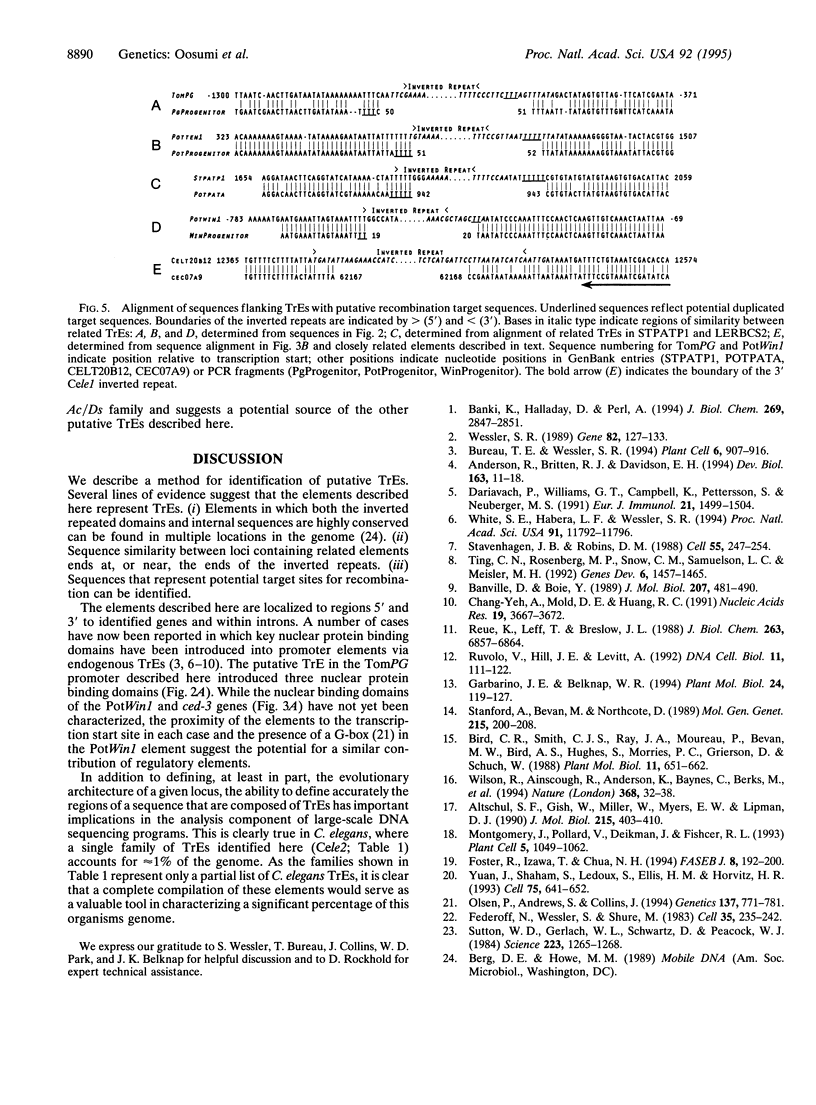
Selected References
These references are in PubMed. This may not be the complete list of references from this article.
- Altschul S. F., Gish W., Miller W., Myers E. W., Lipman D. J. Basic local alignment search tool. J Mol Biol. 1990 Oct 5;215(3):403–410. doi: 10.1016/S0022-2836(05)80360-2. [DOI] [PubMed] [Google Scholar]
- Anderson R., Britten R. J., Davidson E. H. Repeated sequence target sites for maternal DNA-binding proteins in genes activated in early sea urchin development. Dev Biol. 1994 May;163(1):11–18. doi: 10.1006/dbio.1994.1119. [DOI] [PubMed] [Google Scholar]
- Banki K., Halladay D., Perl A. Cloning and expression of the human gene for transaldolase. A novel highly repetitive element constitutes an integral part of the coding sequence. J Biol Chem. 1994 Jan 28;269(4):2847–2851. [PubMed] [Google Scholar]
- Banville D., Boie Y. Retroviral long terminal repeat is the promoter of the gene encoding the tumor-associated calcium-binding protein oncomodulin in the rat. J Mol Biol. 1989 Jun 5;207(3):481–490. doi: 10.1016/0022-2836(89)90458-0. [DOI] [PubMed] [Google Scholar]
- Bureau T. E., Wessler S. R. Stowaway: a new family of inverted repeat elements associated with the genes of both monocotyledonous and dicotyledonous plants. Plant Cell. 1994 Jun;6(6):907–916. doi: 10.1105/tpc.6.6.907. [DOI] [PMC free article] [PubMed] [Google Scholar]
- Chang-Yeh A., Mold D. E., Huang R. C. Identification of a novel murine IAP-promoted placenta-expressed gene. Nucleic Acids Res. 1991 Jul 11;19(13):3667–3672. doi: 10.1093/nar/19.13.3667. [DOI] [PMC free article] [PubMed] [Google Scholar]
- Collins J. J., Anderson P. The Tc5 family of transposable elements in Caenorhabditis elegans. Genetics. 1994 Jul;137(3):771–781. doi: 10.1093/genetics/137.3.771. [DOI] [PMC free article] [PubMed] [Google Scholar]
- Dariavach P., Williams G. T., Campbell K., Pettersson S., Neuberger M. S. The mouse IgH 3'-enhancer. Eur J Immunol. 1991 Jun;21(6):1499–1504. doi: 10.1002/eji.1830210625. [DOI] [PubMed] [Google Scholar]
- Fedoroff N., Wessler S., Shure M. Isolation of the transposable maize controlling elements Ac and Ds. Cell. 1983 Nov;35(1):235–242. doi: 10.1016/0092-8674(83)90226-x. [DOI] [PubMed] [Google Scholar]
- Foster R., Izawa T., Chua N. H. Plant bZIP proteins gather at ACGT elements. FASEB J. 1994 Feb;8(2):192–200. doi: 10.1096/fasebj.8.2.8119490. [DOI] [PubMed] [Google Scholar]
- Garbarino J. E., Belknap W. R. Isolation of a ubiquitin-ribosomal protein gene (ubi3) from potato and expression of its promoter in transgenic plants. Plant Mol Biol. 1994 Jan;24(1):119–127. doi: 10.1007/BF00040579. [DOI] [PubMed] [Google Scholar]
- Montgomery J., Pollard V., Deikman J., Fischer R. L. Positive and negative regulatory regions control the spatial distribution of polygalacturonase transcription in tomato fruit pericarp. Plant Cell. 1993 Sep;5(9):1049–1062. doi: 10.1105/tpc.5.9.1049. [DOI] [PMC free article] [PubMed] [Google Scholar]
- Reue K., Leff T., Breslow J. L. Human apolipoprotein CIII gene expression is regulated by positive and negative cis-acting elements and tissue-specific protein factors. J Biol Chem. 1988 May 15;263(14):6857–6864. [PubMed] [Google Scholar]
- Ruvolo V., Hill J. E., Levitt A. The Tc2 transposon of Caenorhabditis elegans has the structure of a self-regulated element. DNA Cell Biol. 1992 Mar;11(2):111–122. doi: 10.1089/dna.1992.11.111. [DOI] [PubMed] [Google Scholar]
- Stanford A., Bevan M., Northcote D. Differential expression within a family of novel wound-induced genes in potato. Mol Gen Genet. 1989 Jan;215(2):200–208. doi: 10.1007/BF00339718. [DOI] [PubMed] [Google Scholar]
- Stavenhagen J. B., Robins D. M. An ancient provirus has imposed androgen regulation on the adjacent mouse sex-limited protein gene. Cell. 1988 Oct 21;55(2):247–254. doi: 10.1016/0092-8674(88)90047-5. [DOI] [PubMed] [Google Scholar]
- Sutton W. D., Gerlach W. L., Peacock W. J., Schwartz D. Molecular analysis of ds controlling element mutations at the adh1 locus of maize. Science. 1984 Mar 23;223(4642):1265–1268. doi: 10.1126/science.223.4642.1265. [DOI] [PubMed] [Google Scholar]
- Ting C. N., Rosenberg M. P., Snow C. M., Samuelson L. C., Meisler M. H. Endogenous retroviral sequences are required for tissue-specific expression of a human salivary amylase gene. Genes Dev. 1992 Aug;6(8):1457–1465. doi: 10.1101/gad.6.8.1457. [DOI] [PubMed] [Google Scholar]
- Wessler S. R. The splicing of maize transposable elements from pre-mRNA--a minireview. Gene. 1989 Oct 15;82(1):127–133. doi: 10.1016/0378-1119(89)90037-1. [DOI] [PubMed] [Google Scholar]
- White S. E., Habera L. F., Wessler S. R. Retrotransposons in the flanking regions of normal plant genes: a role for copia-like elements in the evolution of gene structure and expression. Proc Natl Acad Sci U S A. 1994 Dec 6;91(25):11792–11796. doi: 10.1073/pnas.91.25.11792. [DOI] [PMC free article] [PubMed] [Google Scholar]
- Wilson R., Ainscough R., Anderson K., Baynes C., Berks M., Bonfield J., Burton J., Connell M., Copsey T., Cooper J. 2.2 Mb of contiguous nucleotide sequence from chromosome III of C. elegans. Nature. 1994 Mar 3;368(6466):32–38. doi: 10.1038/368032a0. [DOI] [PubMed] [Google Scholar]
- Yuan J., Shaham S., Ledoux S., Ellis H. M., Horvitz H. R. The C. elegans cell death gene ced-3 encodes a protein similar to mammalian interleukin-1 beta-converting enzyme. Cell. 1993 Nov 19;75(4):641–652. doi: 10.1016/0092-8674(93)90485-9. [DOI] [PubMed] [Google Scholar]


